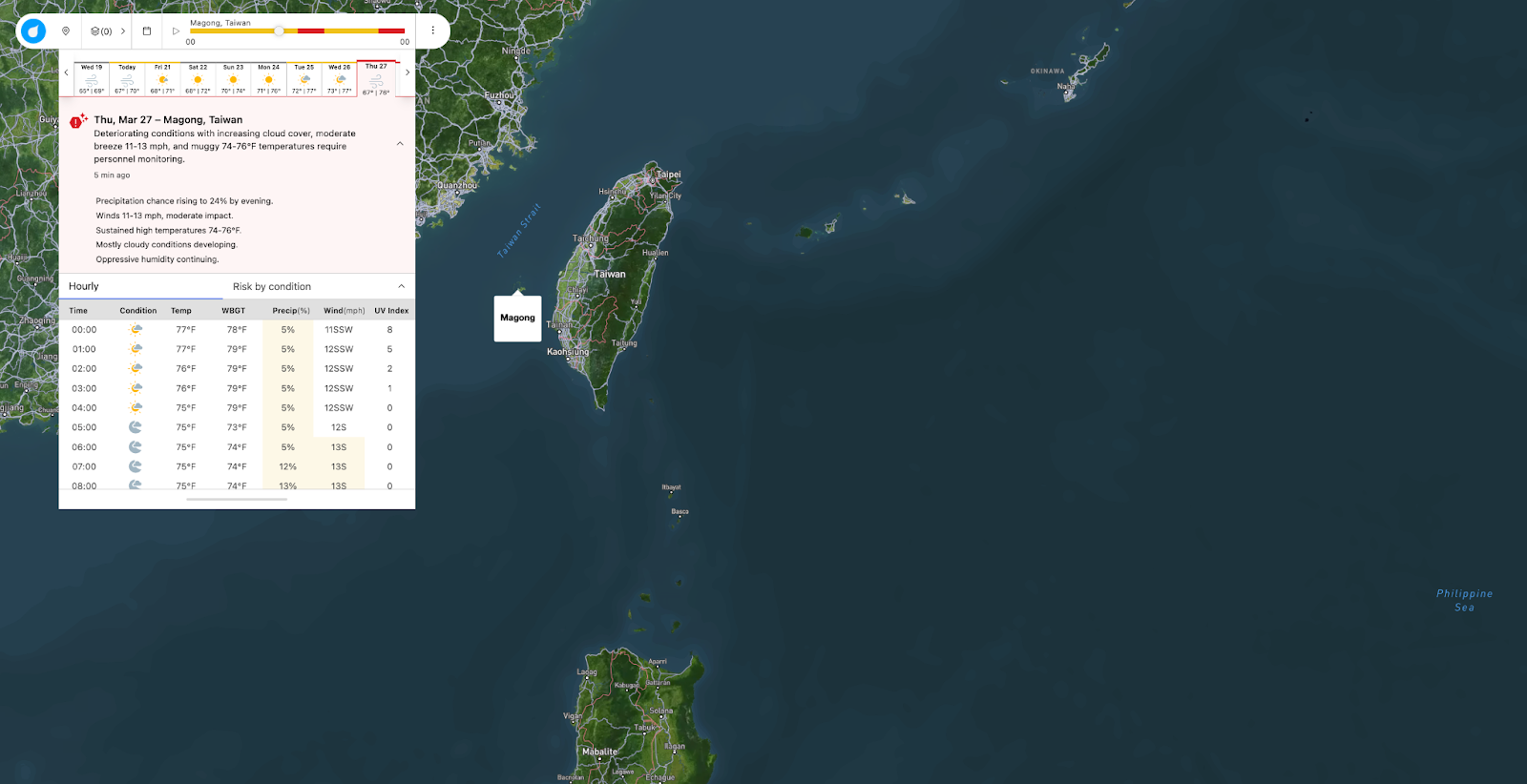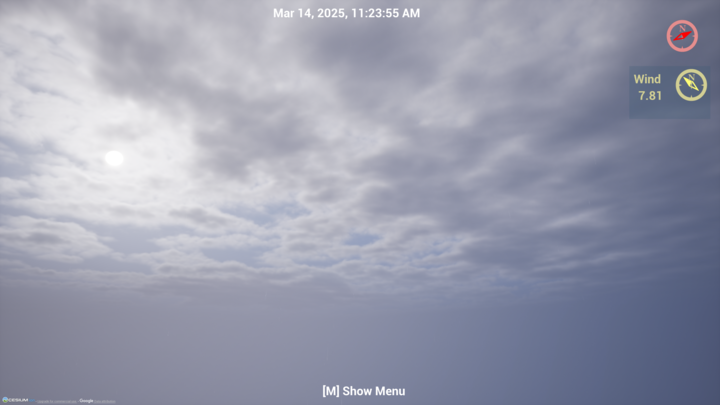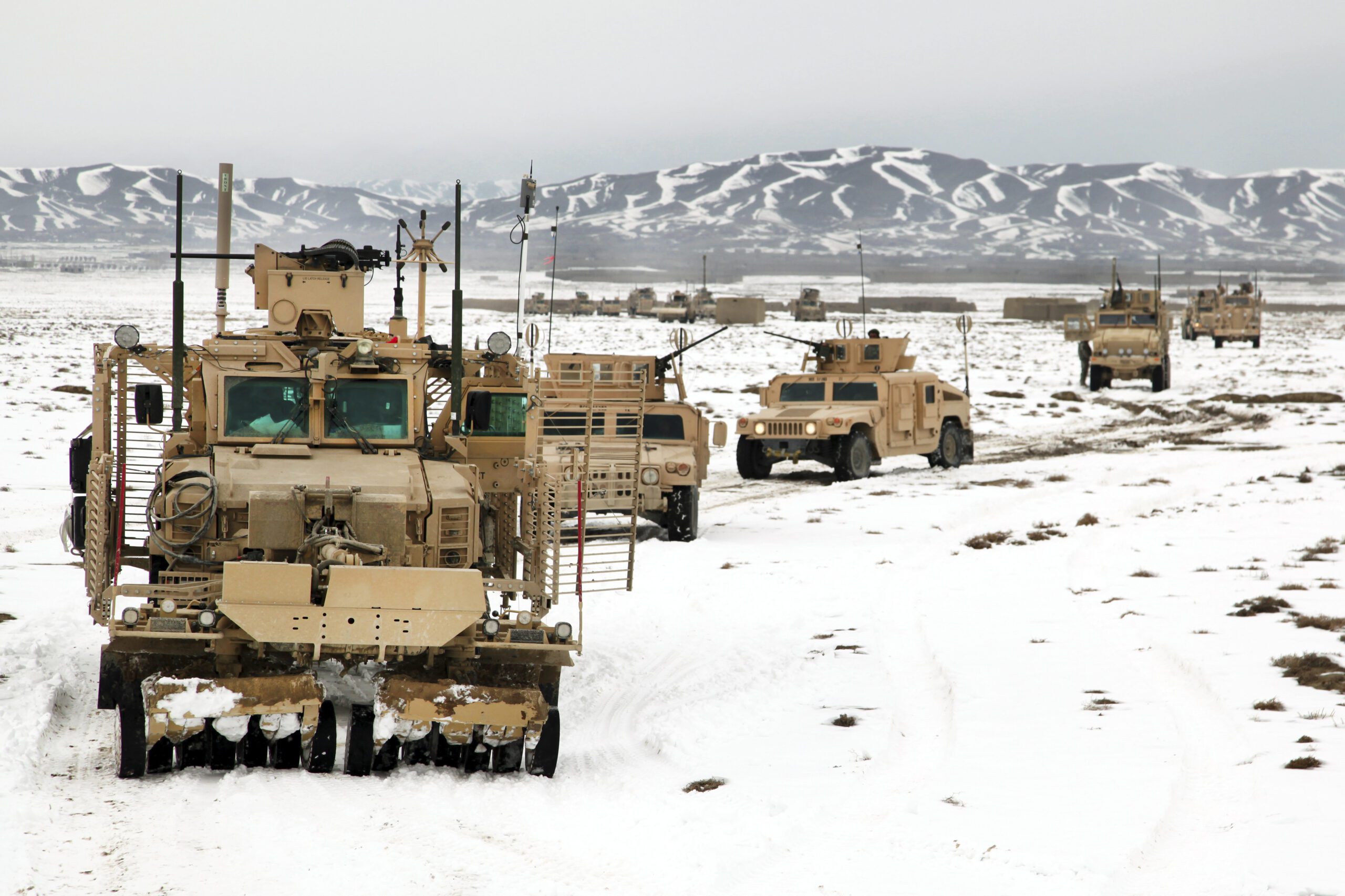Weather intelligence for the future: Crafting a strategic enterprise approach to changing environmental conditions
Continue reading- Weather plays an active role in every phase of mission planning, influencing outcomes more directly than ever.
- Weatherverse™ Sim delivers high-fidelity weather environments for training and simulation platforms, enabling mission rehearsal under realistic atmospheric conditions that reflect actual terrain, forecast, and timing.
- Weatherverse™ Planner translates complex weather data into clear operational impacts, helping mission planners identify risks, align assets to optimal weather windows, and reduce uncertainty during execution.
Military operations succeed when every variable is known. Few are as influential – or as overlooked – as weather. While existing weather reporting capabilities remain a vital resource, many decision makers don’t realize how much more is available.
Forecasting alone doesn’t meet today’s operational needs
A basic forecast shows surface conditions. But what about mission timing, airborne visibility, and shifts that occur within hours, not days? Today’s defense environments demand more than general data. They call for precise, responsive, accurate, and impact-aware systems that adapt as fast as conditions change.
Standard weather tools were built for stability. They offer a broad picture – temperature, precipitation, wind speeds – but they often miss mission-critical details. Tactical teams operating in varied terrain or fast-moving scenarios can’t afford to act on partial information. Gaps in awareness can delay operations, increase risk, or even force mission aborts.
Siloed systems and poor integration slow decision making
Another challenge is integration. Many military weather platforms don’t sync with simulation tools or real-time planning systems. That makes it harder for leaders to adjust as conditions evolve. And since data is scattered across branches, teams are left piecing together their own forecasts.
Many existing military weather reports can’t convey a unified weather picture given the complexity, leaving the end user responsible for interpreting the “so what.” Further, some have heavy bandwidth requirements, limiting access in austere or contested environments. Others fail to present probabilistic ranges – leaving planners in the dark about less likely, but potentially mission-threatening, scenarios. Without tools that provide accurate, timely, and localized forecasts, the odds of weather undermining an operation increase sharply.
Strategic inaction has left a capability gap
The Department of Defense faces structural issues that make this worse. After decades of operating in environments where air superiority was the norm, weather was often seen as a background factor – not a strategic one. That led to the slow adoption of more advanced forecasting systems. Weather data also remains siloed across units, with no unified strategy to guide how it’s shared or applied. And while some specialized teams have begun to innovate, most lack access to a common platform that delivers real-time weather intelligence across all mission levels.
New solutions turn weather into an asset, not a challenge
Unlike other platforms that operate in closed GIS environments or as standalone field apps, Weatherverse Planner is built for synthesis and integration. As one of the most advanced weather intelligence systems available, its plugin architecture works seamlessly with the planning and simulation platforms already used by defense teams – eliminating data silos and reducing tool switching.
While some competitors rely on synthetic data or only pull from limited METAR stations, Weatherverse Planner supports over two million global points, offering significantly broader coverage and real-time relevance. Further, these capabilities can be extended to field teams who can also benefit from mobile-ready capabilities that work even in bandwidth-limited environments.
Built to meet real operational demands
An effective military weather platform needs more than accuracy. It must be global, mobile, and adaptable. Planners should be able to access real-time, localized data – whether they’re in urban environments, mountain passes, or open oceans. Forecasts should account for unit-specific needs, from air wings to armored columns. And systems should support “what-if” planning to explore how different weather conditions could impact mission success. Weatherverse Planner delivers on all these fronts, helping transform raw weather data into operational clarity.
Weather windows provide a tactical edge
One of the more valuable purpose-built capabilities of Weatherverse Planner is “weather windows” – specific timeframes where forecasted conditions meet mission requirements based on the assets being deployed. Variables like cloud cover, wind shear, and visibility can be analyzed in real time against asset attributes to isolate the best operational timing to deploy a mission for optimal success as influenced by weather. In fact, with these capabilities, weather can be seen as not only something that could degrade effectiveness but in some cases can be understood and utilized as an offensive component of a mission or operational plan. Users can act confidently, knowing they’ve aligned every element of the mission to favorable weather.
Condition Manager turns insight into action
Powering much of these differentiated capabilities in Weatherverse Planner is Condition Manager, a proven tool first built and deployed for aviation customers. It tracks how incoming conditions will affect operational assets (tank, dismounted soldiers, drones, aircraft, etc.). Alerts are automated and customizable, so teams receive early warnings across the entire current and forecasted weather window for when operations or objectives might be impacted. The interface is intuitive enough that users without weather expertise can manage it effectively.

Weatherverse Planner Plugin providing an initial layer of weather intelligence on a location (including a contextual AI summary) within a GIS environment.
Weatherverse Sim enhances simulation realism
For teams conducting live, virtual, and constructive simulations, Weatherverse Sim brings real-world weather into immersive training and simulation environments. It is initially designed to support next-generation platforms using the Unreal Engine rendering standard, realistic, physics-aware weather overlays that help enhance readiness and sharpen decision making. This solution delivers real weather (not synthetic) tied to real locations anywhere globally. Incorporation of Weatherverse Sim into Unreal environments significantly improves realism and simulation effectiveness as impacted by weather. Simulation operators are gaining access to world-class weather data and weather science.

Weatherverse Sim visualizing The Weather Company’s forecast weather data for use in a simulator.
Why timing matters more than ever
Modern missions often depend on tight schedules. If a window opens for a successful airlift or amphibious landing, every minute counts. Missing that window, even by a few hours, can compromise the entire strategy.
Planners who understand weather effects on military operations can adjust ahead of time. They can delay, reroute, or re-prioritize without losing momentum. They also avoid the risk of launching under poor conditions, which can put personnel and equipment in danger.
Military planning evolves with better weather data
Military operations planning now includes a broader range of variables than ever before. Weather plays an active role in every phase of mission planning, influencing outcomes more directly than ever. Advanced tools offer the clarity and speed needed to keep up.
The traditional military weather reporting still plays a role but needs support. Solutions like Weatherverse provide that support. They offer deeper insight, faster updates, and a better understanding of how weather aligns with mission success. Weatherverse is powered by The Weather Company, the world’s most accurate forecaster,1 bringing mission-grade precision to every decision point.
Better weather data leads to sharper decisions in fast-moving environments. Commanders rely on precise, location-aware forecasts to guide timing and resource use. Asset-specific alerts help planners adjust quickly, even as conditions evolve. When weather intelligence is fully integrated into mission systems, it strengthens coordination and turns environmental awareness into operational advantage.
Let's talk
To learn more about our integrated weather planning, visualization, and simulation platform for government and defense, contact our experts today.
Contact us1 ForecastWatch, Global and Regional Weather Forecast Accuracy Overview, 2021-2024, commissioned by The Weather Company

